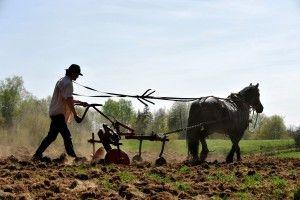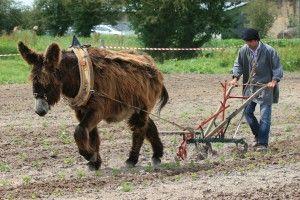Market gardening with horses
What is this ?
Market gardening is the growing of vegetables, some small fruit, some aromatic plants, herbs and flowers for human consumption, as well as medicinal plants, using a horse on a professional basis, with the aim of turning a profit or making a living, which differentiates it from simple gardening
The Advantages of using Horses in Market Gardening
Horses, mules and donkeys are very well-suited to market gardening where tractors are seldom seen. Rather, people use tillers or sometimes micro-tractors in market gardening where surfaces are often small (between 0.80 and 1.20 hectares). They are generally on a human scale that is equal to one unit of labour.
- © JL. Dugast – Maraîchage avec un Mérens
- © E. Rousseaux – Maraîchage avec un Baudet du Poitou
The Agronomic Aspect
Modern animal traction is best at limiting soil compaction. Its most immediate effect is to allow more air in, with this ventilation leading to the growth of bacterial and animal life in the soil and better decay of organic matter.
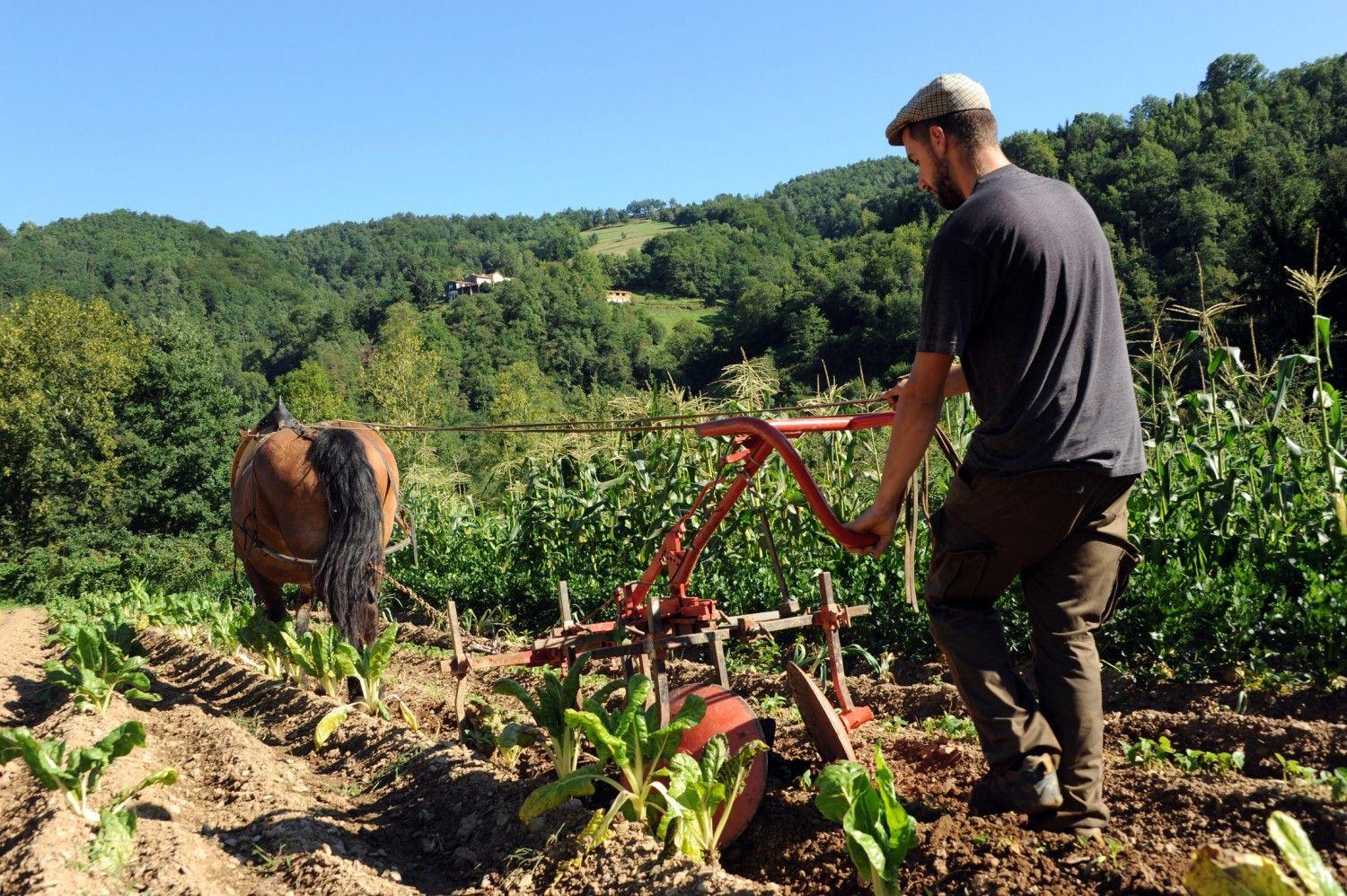
© JL. Dugast – PROMMATA
The Economic Aspect
Using equines allows for financial and technical autonomy in small outfits given the low investment they require (Ref. the sheet on market gardening using animal traction – comparison of equipment, on the website of Association Trait Vienne) and the low operating costs (the energy that is consumed via fodder is recycled as compost and the animal engine can reproduce itself), helped by the wide range of possible activities.
The use of equines in market gardening allows for the development of short channels. It also provides an undeniable promotional and commercial advantage in dealing with customers, due to the excellent brand image it carries.
A study* comparing a 35hp two-wheel drive tractor with a horse shows the horse having a higher yield than the tractor (20% as opposed to 6% for the tractor). This gap is emphasised by the fact that horses can work in almost any type of soil, whatever the weather, whereas the use of tractors is limited by its weight and by the soil compaction it causes. One can also note that horses do not make use of fossil fuel energy and therefore cause neither damage to the ecosystem, nor noise pollution.
This same study also compares a horse to the same tractor driven by a less polluting bio-fuel. The horse still comes off better. The tractor would need the output from five hectares of oilseed crops that produce bio-fuels to run for a whole year whereas a horse only requires the output from one and a half hectares, divided between grass, hay, alfalfa and cereals.
One third of users of equines mention that the investment for the use of an equine is less than that for a motorised vehicle.
*B. Dangeard “Comparaison cheval-tracteur, consummation d’énergie et énergie récupérable” (Horse-Tractor Comparison, energy consumption and recoverable energy)
This statement must however be considered in the light of:
– Animal power is often acquired at a price which does not account for the total cost of its production, and which does not allow the breeders to live adequately off their work);
– Even though it allows the optimisation of the efficiency of animal traction and enhances its credibility, technically efficient equipment such as hoes, weeding brushes, weeding stars, and other tool combinations, tend to up the investment cost required considerably.
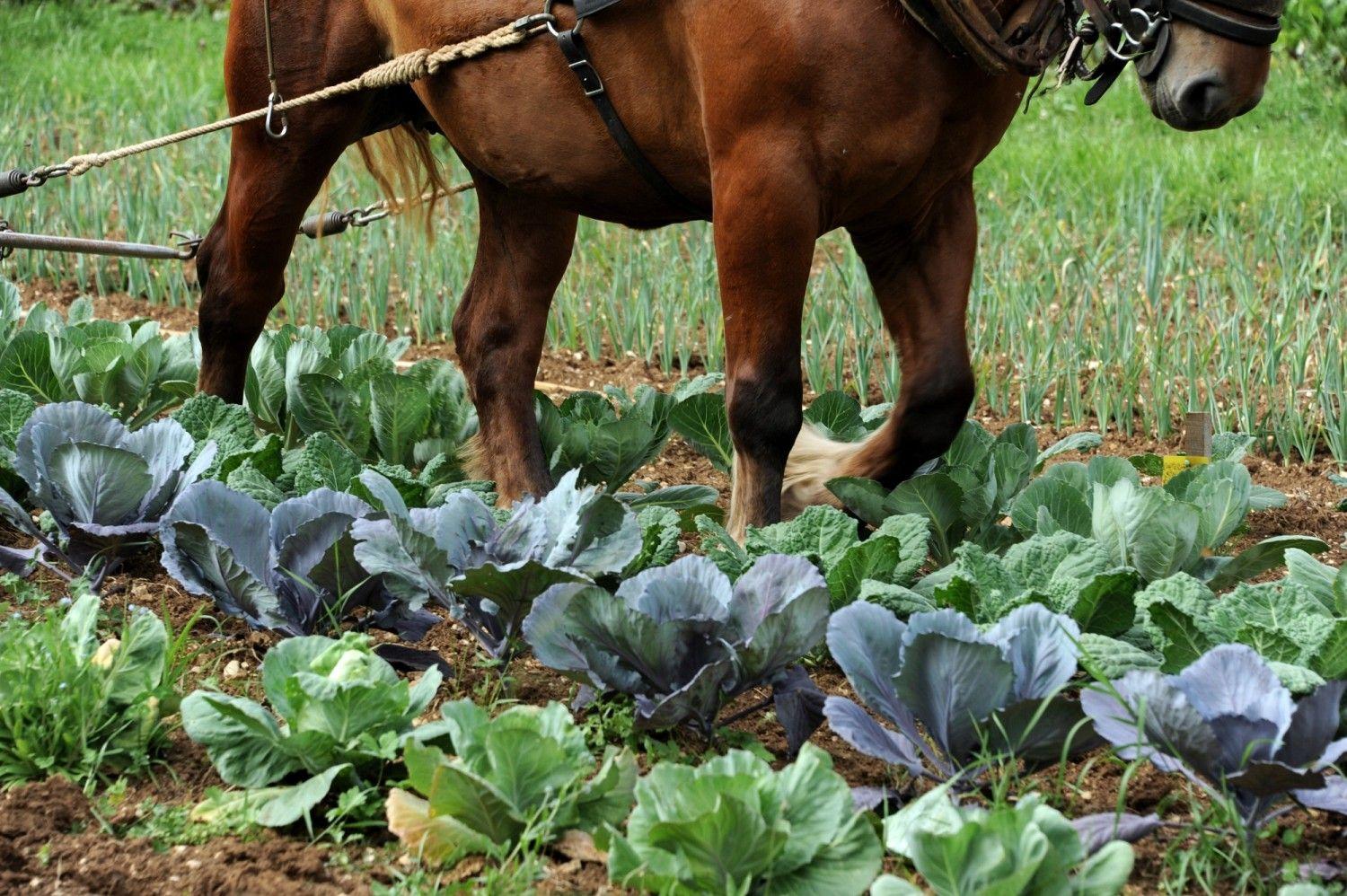
© JL. Dugast – Exploitation maraîchère dans le Jura
The Social Perspective
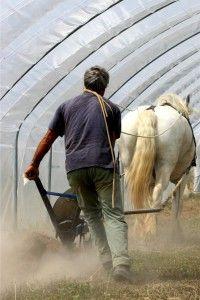
© E. Rousseaux – Maraîchage sous serre
Animal traction is a work tool on a human and environmental scale.
Its use in market gardening gives it a very positive natural image by meeting a growing demand for organic and natural products.
The horse meets the needs of a demanding client base, showing a return of interest in organic architecture and natural cultural techniques. Through its image, it can really add value to regionally-grown products.
The success of the work that is carried out is due in the greater part to the bond between the horse or donkey and their driver as it is necessary to make oneself understood, to request and to get the desired result. Putting in place such a work system requires a different approach towards the work. Animals require a learning period and physical training in order to be able to work correctly.
The life choice is also important. It is crucial to have someone there, to be organised and to have someone who can anticipate what work will be required on the equine side.
Some Figures
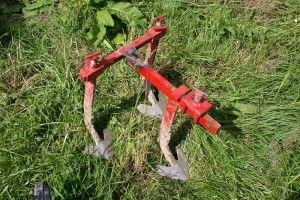
© E. Rousseaux
- It takes 15 minutes to hoe a 500 square metre hothouse .
- A horse can open and close the furrows on one hectare of potatoes in half a day.
- The speed of a horse whilst hoeing is the same at which it walks, which is about 4.5km/h when precise work is being done.
- The ideal spacing between cultivated rows is 70cm but can vary depending on the animal used.
Strength and pulling Power of different animals
| animal | Weight (kg) | Pulling Power (kg) | Normal Speed (m/s) | Power (W) |
| Draft Horse | 700-1200 | 50-100 | 0,8-1,2 | 500-1000 |
| Ordinary Horse | 400-700 | 45-80 | 0,8-1,4 | 400-800 |
| Mule | 350-500 | 40-60 | 0,8-1,0 | 300-600 |
| Donkey | 150-300 | 20-40 | 0,6-0,8 | 75-200 |
| Cow | 400-600 | 50-60 | 0,6-0,8 | 200-400 |
| Bull | 500-900 | 60-80 | 0,5-0,7 | 300-500 |
| Camel | 500-1000 | 80-100 | 0,8-1,2 | 400-700 |
| Buffalo | 400-900 | 60-100 | 0,5-1,0 | 600-1000 |
Source FAO (Food and Agricultural Organization of the United Nations) / Force Motrice Animale (Animal Pulling Power)
Sources : HIPPOTESE
For More information about : Market gardening with horses
- > http://www.assoprommata.org/
- > http://www.civam.org/
- http://traitvienne.jimdo.com/fiches-techniques/maraîchage/
- > www.traitvienne.jimdo.com
